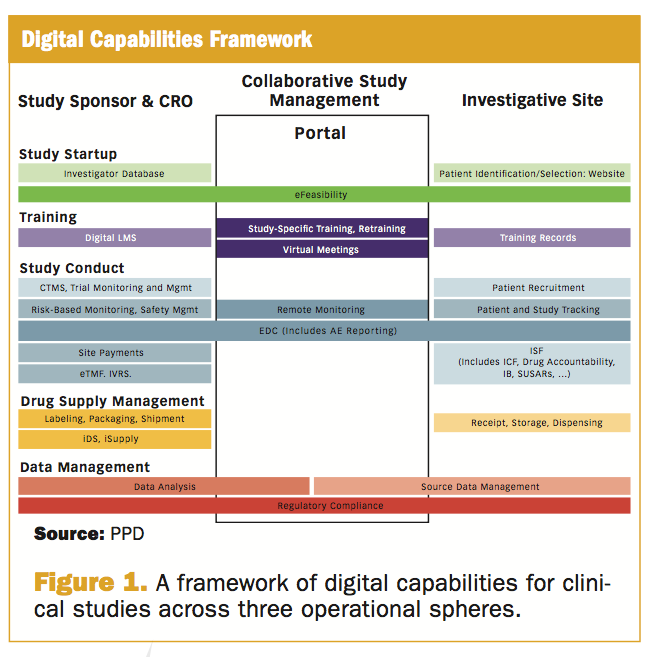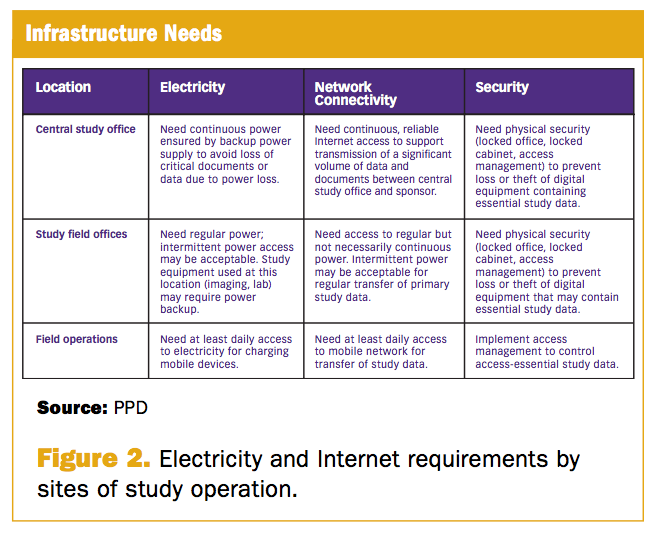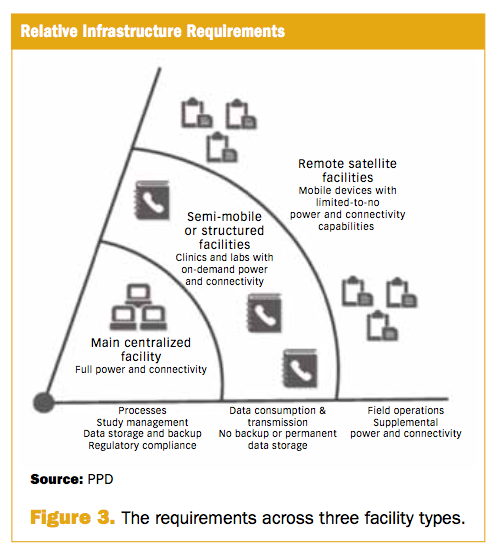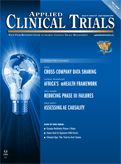Africa a Ripe Proving Ground for Digital Health
Applied Clinical Trials
A proposed operational framework to support digital- and mHealth-based clinical trials in Africa.

Knowledge transfer in clinical drug development has followed a well-worn path from the mature research environments of North America and Europe to the developing regions of Eastern Europe, Asia and Latin America. Digital research technologies could well turn the tables, giving emerging nations an advantage in pioneering digital-based, operational models for 21st century clinical trials.
Digital research platforms-including the current integration of wearable mobile health (mHealth) devices with smartphones to facilitate data collection-promise improvements in both data quality and cost efficiency. Their adoption has been slowed by the need to integrate these fast-evolving technologies within existing research infrastructure and practice. Environments free of legacy systems have the advantage of building comprehensive, “right-by-design” digital and mHealth models spanning all trial operations. Such approaches will be best able to optimize the benefits of digital platforms to improve data accuracy and reduce reliance on costly clinic-based operations. At the same time, digital platforms will facilitate clinical trials in underserved populations where lack of infrastructure has made traditional research models unfeasible.
Africa’s blank slate
While there are wide variations in maturity of industry, infrastructure and clinical capabilities, many believe the cumulative “blank-slate” opportunity is greatest in Africa, which accounts for about 15% of the world’s population but hosts only an estimated 0.9% of global clinical trials.1 Inadequate medical and research infrastructure has made clinical trials cost-prohibitive. Africa’s research landscape is maturing, however, due to economic growth and the rise of non-communicable diseases more characteristic of developed regions.
Africa’s population is expected to reach 2.4 billion by 2050.2 By 2020, non-communicable diseases, including cancer, diabetes, hypertension and cardiovascular disease will account for 65% of mortality.3 As demand for therapies to treat these conditions grows, Africa’s economies are growing as well. GDP is projected to rise to $3.3 trillion in 2020. And, according to a 2015 McKinsey report, Africa’s $20.8 billion pharmaceutical market could reach $60 billion by 2020.4
Africa’s research capabilities are now primed to enable digital trials designed for this special environment. An increasing number of major clinical trials are being supported by collaborations like The World Health Organization’s Special Programme for Research and Training in Tropical Diseases (TDR) and the European and Developing Countries Clinical Trials Partnership (EDCTP) are setting the stage. A 2007 EDCTP report identified qualified Phase II/III clinical sites in 19 sub-Saharan countries with capability to conduct trials in tuberculosis (TB), malaria and HIV.5 Infrastructure now can sustain studies like Wyeth’s 2009 river blindness trial in Ghana, Liberia and Democratic Republic of Congo,6 and the TDR cosponsored TB trial involving 1,800 patients across five countries, published in 2014.7
Digital research platforms have the potential to create a fully capable digital environment in Africa, especially when they incorporate wearable devices and telemedicine approaches that are designed to simplify the participation in a trial for patients and connect them to the best global scientific research regardless of their location. For instance, medical grade wearable sensors integrated with smartphones now enable accurate, continuous real-world data collection, independent of sparsely located clinical sites. Smartphones are widely used in African healthcare settings. Some 21 million new mobile subscribers were tallied in the first quarter of 2015 alone.8
Using today’s available technologies, the following discussion proposes an operational framework to support African-based digital studies across trial operations-from site initiation and patient enrollment through study conduct, data collection and site closeout.
A digital framework for Africa
In Africa, digital research platforms will have three fundamental requirements: cost-effective digital technologies to support operations across clients, service providers and investigative sites; reliable electrical power and Internet connectivity; and regulatory acceptance of and study compliance with digital technologies and approaches.
Figure 1 below outlines a framework of digital capabilities currently used to conduct studies across three operational spheres: activities conducted by the client; activities conducted in collaboration with technology and service providers, primarily contract research organizations (CRO); and activities conducted by investigative sites. These technologies enable pre-trial intelligence (study feasibility and identification/recruitment of investigator sites); training for site personnel; study management; document management; drug supply management; and data management.
Using these digital technologies, three operations centers would be sufficient to conduct all trial activities:
- A central study office-such as a project office at a university teaching hospital-would be responsible for study coordination.
- Study field offices-either central or remotely located-would conduct subsets of activities for multiple patients. These include central laboratories, imaging facilities and primary health clinics supporting treatment and follow-up.
- Field operations would conduct small subsets of tasks for a small set of patients. For example, community health workers administering surveys or collecting data during visits to patients’ homes.

Figure 2 below details the necessary infrastructure requirements for participating study centers, which includes access to electrical power, network Internet connectivity, physical security to protect study materials and data, and the ability to control access to essential data.

Access to power and Internet communications typically are barriers to conducting trials in Africa. The digital platform suggested here would increase the feasibility of African-based trials since lower levels of access are sufficient for different

operational centers. Only the central study office would require continuous power and connectivity. Field offices and operations would need daily access but could fully meet study responsibilities with intermittent power and Internet access, as illustrated in Figure 3 at right.
Evolving regulation
While not losing sight of the challenges that still need to be overcome to address political instability, corruption and the absence of reliable shipping and storage facilities for clinical trial supplies in some regions, Africa is evolving. The regulatory environment is maturing through standards and practices specifically pertaining to Africa with, for example, ethical guidelines developed by the Swiss Tropical and Public Health Institute (Swiss TPH)9 and a regional trial registry created by the Pan African Clinical Trials Registry (PACTR).10
Historically, sponsors have conducted African trials in compliance with the U.S. Food and Drug Administration (FDA), European Medicines Agency (EMA) and other global standards. Regulations are emerging to guide the implementation of digital approaches, but regulators are hard-pressed to stay current with fast-moving digital and mHealth technologies. FDA issued guidances in 2014 and 2015 presenting regulatory views on the use of mHealth devices in clinical trials.11,12 Other pertinent guidelines include: FDA guidance on use of electronic source (eSource) data (2013)13; standards for eSource data standards of the Clinical Data Interchange Standards Consortium (CDISC)14; and EMA’s reflection paper on eSource data and EDC tools (2010).15
Conclusion
This proposed operational framework for digital-based clinical trials in Africa is intended as a starting point toward three important goals: expanding drug development research in underserved African populations; laying the technology groundwork for developing and building scientific expertise; and piloting “right-by-design” digital research approaches in a blank-slate environment free of legacy infrastructures that slow adoption of disruptive methodologies. The technologies described in this article are available now. Their utility and benefits have been demonstrated, and they currently are used in clinical trials to improve data collection, data management, safety monitoring and informed consent. Africa offers a compelling opportunity to pilot digital and mHealth research platforms to revolutionize clinical trial operations worldwide.
David Blackman is Business Innovation Director, PPD
References
1. M. Bairu and R. Chin (eds.), “Global Clinical Trials Playbook: Capacity and Capability Building,” Elsevier, Academic Press, London, 2012.
2. Population Reference Bureau, “World Population Data Sheet 2014,” http://www.prb.org/Publications/Datasheets/2014/2014-world-population-data-sheet/data-sheet.aspx
3. World Health Organization, “Non Communicable Disease Prevention and Control Overview, Regional Office for Africa,” http://www.afro.who.int/en/clusters-a-programmes/dpc/non-communicable-diseases-managementndm/overview.html
4. T. Holt, M. Lahrichi, J. Mina and J.S. DaSilva, “Insights into Pharmaceuticals and Medical Products. Africa: A Continent of Opportunity for Pharma and Patients,” McKinsey and Company, 2015
5. S. Agwale, “Identification of Credible Clinical Trials Sites in Africa,” Second DCC/ENNP Joint Meeting, Douala, May 9, 2007, http://www.edctp.org/fileadmin/documents/NOE_-_Simon_Agwale.pdf
6. World Health Organization, “New Drug Being Tested in Africa for River Blindness,” News Release, July 2009, http://www.who.int/mediacentre/news/releases/2009/river_blindness _20090701/en/
7. World Health Organization, “Boost for Research Capacity in West Africa Tropical Disease Research,” News Release, October 2014, http://www.who.int/tdr/news/2014/research-capacity-west-africa/en/
8. Ericsson Mobility Report, June 2015, http://www.ericsson.com/res/docs/2015/ericsson-mobility-report-june-2015.pdf
9. Training and Resources in Research Ethics Evaluation (TRREE), http://elearning.trree.org/
10. The Pan African Clinical Trials Registry (PACTR), http://www.pactr.org/
11. U.S. Food and Drug Administration, “Draft Guidance for Industry: Intent to Exempt Certain Class II and Class I reserved Medical Devices from Premarket Notification Requirements,” August 2014, http://www.fda.gov/ucm/groups/fdagov-public/@fdagov-meddev-gen/documents/document/ucm407292.pdf
12. U.S. Food and Drug Administration, “Guidance for Industry: Mobile Medical Applications,” February 2015, http://www.fda.gov/downloads/MedicalDevices/.../UCM263366.pdf
13. U.S. Food and Drug Administration, “Guidance for Industry: Electronic Source Data in Clinical Investigations,” September 2013, http://www.fda.gov/downloads/drugs/guidancecomplianceregulatory information/guidances/ucm328691.pdf
14. Clinical Data Interchange Standards Consortium (CDISC), “Electronic Source Data Interchange (eSDI) Group: Leveraging the CDISC Standards to Facilitate the Use of Electronic Source Data within Clinical Trials,” November 2006, http://www.cdisc.org/system/files/all/reference_material_category/application /pdf/esdi.pdf
15. European Medicines Agency, “Reflection Paper on Expectations for Electronic Source Data and Data Transcribed to Electronic Data Collection Tools in Clinical Trials,” June 2010, http://www.ema.europa.eu/docs/en_GB/document_library/Regulatory_and _procedural_guideline/2010/08/WC500095754.pdf

Improving Relationships and Diversifying the Site Selection Process
April 17th 2025In this episode of the Applied Clinical Trials Podcast, Liz Beatty, co-founder and chief strategy officer, Inato, discusses a number of topics around site engagement including community-based sites, the role of technology in improving site/sponsor relationships, how increased operational costs are impacting the industry, and more.
Behind the Buzz: Why Clinical Research Leaders Flock to SCOPE Summit
February 7th 2025In this episode, we meet with Micah Lieberman, Executive Conference Director for SCOPE Summit (Summit for Clinical Ops Executives) at Cambridge Innovation Institute. We will dive deep into the critical role of collaboration within the clinical research ecosystem. How do we bring together diverse stakeholders—sponsors, CROs, clinical trial tech innovators, suppliers, patients, sites, advocacy organizations, investors, and non-profits—to share best practices in trial design, program planning, innovation, and clinical operations? We’ll explore why it’s vital for thought leaders to step beyond their own organizations and learn from others, exchanging ideas that drive advancements in clinical research. Additionally, we’ll discuss the pivotal role of scientific conferences like SCOPE Summit in fostering these essential connections and collaborations, helping shape the future of clinical trials. Join us as we uncover how collective wisdom and cross-industry partnerships are transforming the landscape of clinical research.
FDA-Approved Gene Therapy Beqvez Shows Sustained Efficacy, Safety in Long-Term Hemophilia B Trial
April 17th 2025Beqvez (fidanacogene elaparvovec), an FDA-approved one-time gene therapy for hemophilia B, demonstrated sustained factor IX expression, low bleeding rates, and a favorable safety profile over long-term follow-up.